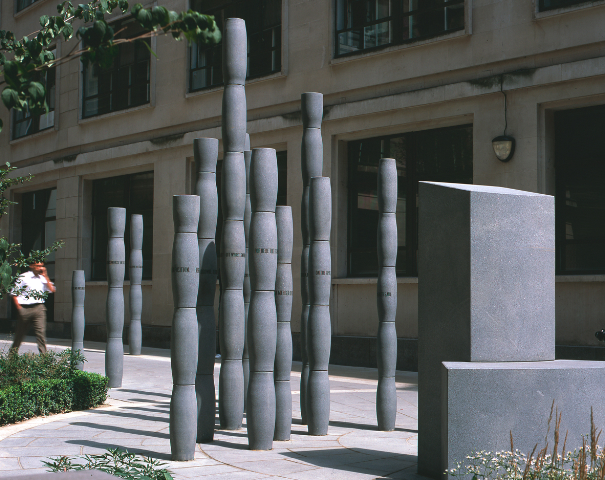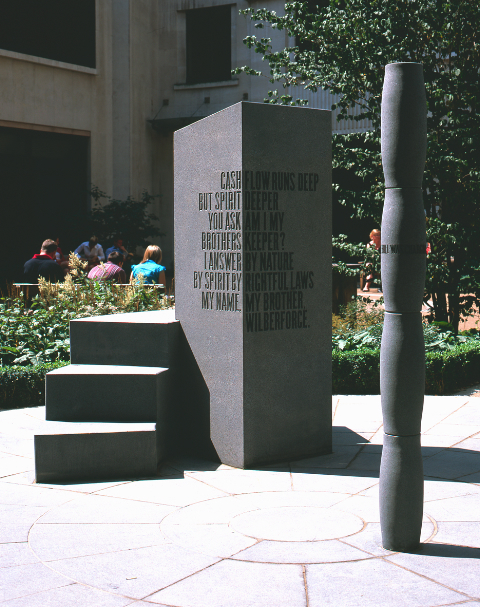Occasional Paper: 'The uneasiness inherent in culture: A note on Michael Visocchi's Memorial to the Abolition of the Transatlantic Slave Trade'
Murdo Macdonald
In spring 2007, Scottish artist Michael Visocchi [1] was awarded a public commission to design a memorial artwork to commemorate the bicentenary of the abolition of the transatlantic slave trade. This was jointly commissioned by the City of London and Black British Heritage, curated and managed by Futurecity. Talking about this commission Visocchi recalled the teaching of David Harding at the Glasgow School of Art: ‘the context is half the work’. Nothing could be truer of this project set in the heart of the City of London, a place which like Glasgow owes so much of its development to the commercial exploitation of commodities such as sugar — commerce made possible by the labour of African slaves transported to the islands of the Caribbean.
The commissioners’ key aims were both to recognise the impact of the legacy of the transatlantic slave trade, and to explore local connections with slavery and the abolitionist movement within the City of London. The site selected, to the north of Fenchurch Street, near Richard Rogers’ Lloyds building and in the heart of the financial district of the City of London, satisfies both aims. Fen Court is the former churchyard of St. Gabriel Fenchurch, destroyed during the 1666 Great Fire of London. Three raised tombs are the only remaining visual evidence of ecclesiastical activity within the site. The immediate physical context of Michael Visocchi’s work is thus a lane which contains an old graveyard. A site devoted to matters of life and death within the wider structure of a city which now serves a globalised economy and seems to be unconcerned with either. This is indeed an appropriate place for reflection on slavery, its abolition and its continued existence. Visocchi notes the tombs remaining within the site and thus his thinking had to respect both the abolition of slavery with the actuality of the graveyard. He took the idea of the context being half the work to the Fen Court site and brought it together with his established interest in ecclesiastical architecture. He says: ‘I managed to utilise the fact that this previous church site could in someway enhance the actual sculpture’ not least because the abolition movement was centred round the churches of the time. Visocchi became acutely aware that many Quaker abolitionists had met not far from the site of the memorial, and a few hundred yards away was the church where John Newton preached to William Wilberforce.
As Visocchi notes this close Newton-Wilberforce link gives this small area of London something of its abolitionist force. Newton had a strong influence on the young Wilberforce, encouraging him to remain in politics to achieve his goal of abolition, rather than give up in favour of a quieter life in the clergy. Newton’s life sums up the ironies of the British slave trade. He was himself forced into service with the Royal Navy at the age of eleven, an early brutalisation which gives context to his later commercial success in that most brutal of naval professions, that of a slave ship captain. But coming close to death in Africa changed the course of his life. He became a Christian and in due course he was ordained. He is well known as the author of the enduring hymn Amazing Grace, but more important here is that Wilberforce used Newton’s public confession of his role in the slave trade to support the abolition campaign.
Visocchi is keen to stress that the emotional energy of the site comes also from its location close to the disused printing workshop where the abolition movement first met, giving metaphorical emphasis to the importance of print as a medium for the abolitionists. This importance of words – printed, spoken and listened to — also resonates with the poetry of Lemn Sissay which is integral to the sculpture. But for Visocchi the key to the work was in the unlocking of its form. His artwork incorporates seventeen cylindrical granite columns erected before a granite platform. The columns take the form of stylised sugar cane stems with segmented growth rings, and [their?] [they comprise] different widths and heights allude to a congregation of figures positioned in front of the platform. Seventeen reflects the number of years activists lobbied Parliament before the bill was passed in 1807. Visocchi thus found the key to the work in the structure of sugar cane, which in the sculpture itself will be transformed into that enduring stone, granite. ‘The more research I did on the whole anti-slavery moment – I was slightly intimidated by it to begin with – but the more I looked into it, the more I realised that there was a potential poetic way into the subject matter through the idea of sugar and simply the architectural shapes of sugar cane itself. It is something I remember when I was a child – getting a bit of sugar cane from a relative, I don't know where they got it …. I remember being fascinated by this plant that could be crushed and distilled and was incredibly sweet.’ ‘The idea was that I could somehow use these sugar cane shapes so that they could be read on the site as figures, as anthropomorphic forms — and therefore could they not then surround a pulpit as a congregation? Of course the pulpit or certainly the raised platform has associations with the auctioneer’s stance, the parliamentary stand and the courtroom dock as well. These are all linked into the story, so this pulpit form has a multiple meaning. The job was then to stylise these canes so that they read as sugar cane but had a more sculptural feel about them, a more volumetric feel. Sugar cane is like bamboo in a way, slightly convex. I have slightly increased the volume of each segment on these columns partly for aesthetic reasons but also to reference the idea of sugar barrels which would have come into the dock near by, so they are very slightly barrel shaped elements; they all sit vertically one on top of the other.’
Although my focus here is Visocchi’s sculptural work, the pulpit form within this columnar congregation is another reminder of the importance of the word. Not just for Wilberforce as an orator and parliamentarian, but for Lemn Sissay whose poem is carved into the granite of both the pulpit and, in fragmentary form, into the columns. A line of text adorns each column as a band or collar, further anthropomorphising the columns and calling to mind the physical restraints placed upon the enslaved. The resonance and contrast of this poetry with the engraved words which characterise an old religious site is very clear. In addition the poetry uses the language of the City of London, trading floors and the like. This is, of course, the chillingly dispassionate language of the slave trade, also.
It is worth noting here that Michael Visocchi is a younger member of that remarkable group of Italian-Scots artists that includes such figures as Richard Demarco and Eduardo Paolozzi. Sitting in the Café Royal in Edinburgh we were conscious as we talked that we were within a few hundred yards of Paolozzi’s Manuscript of Monte Cassino, one of the most uncompromising of all that artist’s public sculptures. It has a resonance with Visocchi’s London project for it is one of Paolozzi’s most deliberate memorial works. The largest element of it is the damaged foot of the being whom Paolozzi took as best representing the condition of the artist, the Greek god Hephaistos, the maker of things. The entire work recalls not only classicism but medieval Latin poetry and the physical and cultural fragmentation of war. Paolozzi knew that the artist and the psychoanalyst work with the same material, what Freud called ‘the uneasiness inherent in culture’, the paradox of the creativity of the human condition. [2] All artists work within this frame. It certainly applies to Michael Visocchi’s abolition memorial, a work shot though by the uneasiness of its historical context and physical place.
A more direct influence on Visocchi than the agglomeration and sorting of cultural fragmentation that characterises the work of Eduardo Paolozzi, is the formal and intellectual elegance of the work of Ian Hamilton Finlay. The classical references that inform Finlay’s work are again resonant for the time of the slave trade at its height was also the time when London architects, led by Scots like Robert Adam and James Gibbs, were actively transforming that city into a place of classically proportioned buildings fit for the work and relaxation of the leadership class of an imperial power. The uneasiness inherent in culture again could hardly be clearer. It might be inaccurate to call this an architecture built on slavery, but it is certainly an architecture funded by a careless exploitation of resources, human and otherwise.
As human beings we try to remember these things. One way we do this is through visual art. I would suggest that all works of art can be considered to be kinds of memorial and thus what Michael Visocchi is engaged with here is an activity fundamental to the artist. It is interesting to look at public art in this way, because it allows one to see it as central to the activity of the artist rather than as a kind of civic add-on. That is why such works, if they are any good, are important. They are not only central to the artist, they are central to all of us. They make us reflective. Sometimes the thinking required is regarded by some as so intolerable that the monument is destroyed, as with Richard Serra’s Tilted Arc in New York in 1989, or the ancient Buddhist sculptures at Bamiyan in Afghanistan in 2001. But more often those able to contemplate outweigh those who are angered by the challenge of thinking. A work like Rodin’s Burghers of Calais helps us, slowly, to think. So also with Michael Visocchi’s commemoration of the abolition of the transatlantic slave trade.
NOTES
[1] Since graduating from Glasgow School of Art in 2001, Michael Visocchi has exhibited widely in the UK and abroad, and has won many awards and bursaries for his work. In 2004 Visocchi was elected the youngest ever Academician of the Royal Scottish Academy. He currently lives and works in Edinburgh and Angus, Scotland. The present article is based on a conversation with the artist in Edinburgh, on 27 February 2008. Images by courtesy of the artist.
[2] The phrase comes from the title of one of Freud's famous texts: Das Unbehagen in der Kultur (The Uneasiness Inherent in Culture), usually translated in English as Civilisation and its Discontents.


